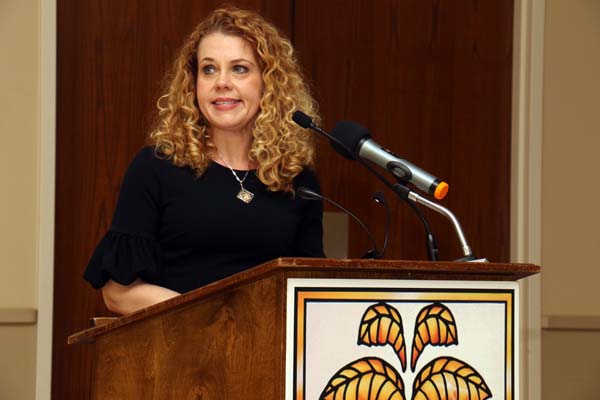Talking tobacco

Beth Farrell
U.S. tobacco growers contemplate the industry’s challenges and opportunities during Tobacco Associates’ annual meeting.
TR Staff Report
Remaining competitive in the global tobacco market will require a relentless focus on quality, compliance and efficiency. That was the message to American growers during Tobacco Associates’ 72nd annual meeting in Wilson, North Carolina, USA, on March 1.
U.S. tobacco farmers have had a rough ride. Adverse weather conditions, rising labor cost, unfavorable exchange rates and a trade war made for a dismal 2018. Many tobacco farming communities are still smarting from Hurricane Florence, which caused severe flooding in the Carolinas last September. Leaf sales to China—a major customer for U.S. growers—have all but dried up after China hiked its import tariffs in retaliation for similar moves by the U.S.
Beth Farrell, agricultural programs specialist at the North Carolina Department of Agriculture and Consumer Services, urged China and the U.S. to settle their trade dispute through negotiations, noting that Brazil has been eager to fill the void left by American tobacco farmers. “Brazil is a formidable competitor,” she cautioned. “Its leaf may not be as good as ours yet, but it is good enough for many buyers.”
Adding to U.S. tobacco growers’ woes, the strong U.S. dollar has further increased the price discrepancy between American leaf and that from other origins. American leaf is well-regarded globally, but it tends to be expensive, and some countries are catching up quickly in terms of quality.
Those challenges come on top of declining demand for tobacco in the wake of shrinking cigarette sales. During the Wilson meeting, TMA Chief Operating Officer Darryl Jayson detailed the decline. U.S. smokers bought 235 billion cigarettes in 2018, down from 247 billion the previous year, according to TMA figures. In the decade to 2018, the U.S. cigarette market volume shrunk by a whopping 31.9 percent. According to Jayson, the market could drop to below 200 billion over the next two years—less than one-third of what it was in the 1980s.
With shrinking demand at home, U.S. farmers have increasingly been looking for sales abroad—and to Tobacco Associates to help them develop those markets. Established in 1947, the organization promotes American flue-cured Virginia (FCV) tobacco outside of the U.S. through a series of educational and training programs.
Tobacco Associates president Hank Mozingo provided an overview of the organization’s activities in 2018, which included visits to customers in Vietnam, Indonesia and the Middle East, along with a leaf training and study program in the U.S. He proudly noted Tobacco Associates’ role in helping Saigon Tobacco Co. (STC) regain its position as the No. 1 cigarette manufacturer in Vietnam. STC’s comeback, he said, was a direct result of the success of the Saigon Virginia and Saigon Silver brands, which were developed with Tobacco Associates technical guidance and assistance.
Proper handling and processing are just as important as choosing the right leaf, according to Tobacco Associates’ chief technical consultant, Bill Luffman. “You can buy high-quality Angus beef, but if you dress it with taco seasoning, it won’t be a fillet—it will be a taco,” he said. Overflavoring and overprocessing are common mistakes, in Luffman’s experience. Tobacco Associates shows customers how to reduce artificial flavorings with American tobacco, which is naturally flavorful. Often, the higher cost of using U.S. leaf can be offset by savings on other ingredients, according to Luffman.
“Price is what you pay; value is what you get,” observed Tobacco Associates treasurer Robert Spiers, quoting celebrity investor Warren Buffett.
George Scott, vice president of leaf at Universal Leaf North America, reviewed the latest trends in the global leaf market. Despite declining cigarette sales in nearly every market, global FCV production is estimated to increase in 2019, driven mainly by large crops in Brazil and Zimbabwe. Scott speculated that some of those volumes could be driven by demand from illicit traders. He also said the rise of “new age” products, such as e-cigarettes and heat-not-burn devices, presents a challenge to tobacco farmers because these devices use little or no leaf.
After leveling off in 2016–2017, the vapor market resumed its growth in 2018, according to Jayson. He expects market leader Juul, in particular, to do well in the upcoming year, despite the U.S. Food and Drug Administration’s (FDA) crackdown on flavors. Jayson believes Juul’s popularity is due not to the product’s flavors—which are bland by vapor industry standards—but to its slick design and the fact that it is able to deliver a cigarette-like nicotine “hit”—something that many other closed-system products have struggled to achieve. “With Juul, the FDA is barking up the wrong tree,” said Jayson about the agency’s obsession with flavors.
While the success of Juul and other vapor products will not revive tobacco growers’ fortunes, Jayson is encouraged by the legalization of cannabis in many jurisdictions. Diversifying into industrial hemp and related products presents a viable opportunity for tobacco farmers, he said. The experience of Kentucky, a traditional tobacco growing state is inspiring in this respect: The number of industrial hemp operations in Kentucky has expanded fivefold recently.







